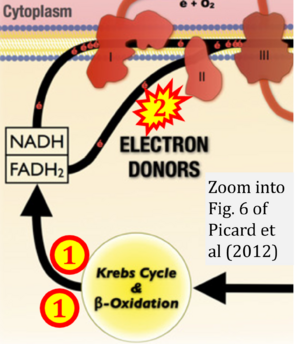Picard 2012 Am J Respir Crit Care Med
| Picard M, Jung B, Liang F, Azuelos I, Hussain S, Goldberg P, Godin R, Danialou G, Chaturvedi R, Rygiel K, Matecki S, Jaber S, Des Rosiers C, Karpati G, Ferri L, Burelle Y, Turnbull DM, Taivassalo T, Petrof BJ (2012) Mitochondrial dysfunction and lipid accumulation in the human diaphragm during mechanical ventilation. Am J Respir Crit Care Med 186:1140-9. https://doi.org/10.1164/rccm.201206-0982OC |
Picard M, Jung B, Liang F, Azuelos I, Hussain S, Goldberg P, Godin R, Danialou G, Chaturvedi R, Rygiel K, Matecki S, Jaber S, Des Rosiers C, Karpati G, Ferri L, Burelle Y, Turnbull DM, Taivassalo T, Petrof BJ (2012) Am J Respir Crit Care Med
Abstract: Rationale: Mechanical ventilation (MV) is associated with adverse effects on the diaphragm, but the cellular basis for this phenomenon, referred to as ventilator-induced diaphragmatic dysfunction (VIDD), is poorly understood.
Objectives: To determine whether mitochondrial function and cellular energy status are disrupted in human diaphragms after MV, and the role of mitochondria-derived oxidative stress in the development of VIDD.
Methods: Diaphragm and biceps specimens obtained from brain-dead organ donors who underwent MV (15-176 h) and age-matched control subjects were compared regarding mitochondrial enzymatic function, mitochondrial DNA integrity, lipid content, and metabolic gene and protein expression. In addition, diaphragmatic force and oxidative stress after exposure to MV for 6 hours were evaluated in mice under different conditions.
Measurements and main results: In human MV diaphragms, mitochondrial biogenesis and content were down-regulated, with a more specific defect of respiratory chain cytochrome-c oxidase. Laser capture microdissection of cytochrome-c oxidase-deficient fibers revealed mitochondrial DNA deletions, consistent with damage from oxidative stress. Diaphragmatic lipid accumulation and responses of master cellular metabolic sensors (AMP-activated protein kinase and sirtuins) were consistent with energy substrate excess as a possible stimulus for these changes. In mice, induction of hyperlipidemia worsened diaphragmatic oxidative stress during MV, whereas transgenic overexpression of a mitochondria-localized antioxidant (peroxiredoxin-3) was protective against VIDD.
Conclusions: Our data suggest that mitochondrial dysfunction lies at the nexus between oxidative stress and the impaired diaphragmatic contractility that develops during MV. Energy substrate oversupply relative to demand, resulting from diaphragmatic inactivity during MV, could play an important role in this process.
• Bioblast editor: Gnaiger E
Correction: FADH2 and Complex II
- FADH2 is shown as the substrate feeding electrons into Complex II (CII). This is wrong and requires correction - for details see Gnaiger (2024).
- Gnaiger E (2024) Complex II ambiguities ― FADH2 in the electron transfer system. J Biol Chem 300:105470. https://doi.org/10.1016/j.jbc.2023.105470 - »Bioblast link«
Labels:
Enzyme: Complex II;succinate dehydrogenase
Pathway: F


